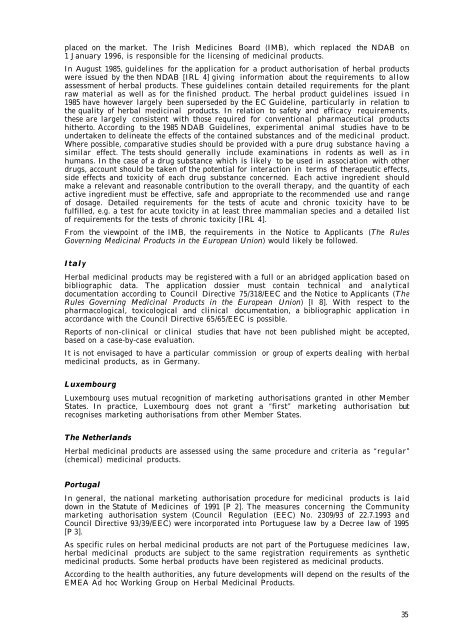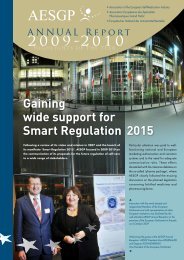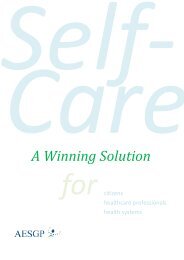Herbal medicinal products in the European Union - AESGP
Herbal medicinal products in the European Union - AESGP
Herbal medicinal products in the European Union - AESGP
Create successful ePaper yourself
Turn your PDF publications into a flip-book with our unique Google optimized e-Paper software.
placed on <strong>the</strong> market. The Irish Medic<strong>in</strong>es Board (IMB), which replaced <strong>the</strong> NDAB on<br />
1 January 1996, is responsible for <strong>the</strong> licens<strong>in</strong>g of <strong>medic<strong>in</strong>al</strong> <strong>products</strong>.<br />
In August 1985, guidel<strong>in</strong>es for <strong>the</strong> application for a product authorisation of herbal <strong>products</strong><br />
were issued by <strong>the</strong> <strong>the</strong>n NDAB [IRL 4] giv<strong>in</strong>g <strong>in</strong>formation about <strong>the</strong> requirements to allow<br />
assessment of herbal <strong>products</strong>. These guidel<strong>in</strong>es conta<strong>in</strong> detailed requirements for <strong>the</strong> plant<br />
raw material as well as for <strong>the</strong> f<strong>in</strong>ished product. The herbal product guidel<strong>in</strong>es issued i n<br />
1985 have however largely been superseded by <strong>the</strong> EC Guidel<strong>in</strong>e, particularly <strong>in</strong> relation to<br />
<strong>the</strong> quality of herbal <strong>medic<strong>in</strong>al</strong> <strong>products</strong>. In relation to safety and efficacy requirements,<br />
<strong>the</strong>se are largely consistent with those required for conventional pharmaceutical <strong>products</strong><br />
hi<strong>the</strong>rto. Accord<strong>in</strong>g to <strong>the</strong> 1985 NDAB Guidel<strong>in</strong>es, experimental animal studies have to be<br />
undertaken to del<strong>in</strong>eate <strong>the</strong> effects of <strong>the</strong> conta<strong>in</strong>ed substances and of <strong>the</strong> <strong>medic<strong>in</strong>al</strong> product.<br />
Where possible, comparative studies should be provided with a pure drug substance hav<strong>in</strong>g a<br />
similar effect. The tests should generally <strong>in</strong>clude exam<strong>in</strong>ations <strong>in</strong> rodents as well as i n<br />
humans. In <strong>the</strong> case of a drug substance which is likely to be used <strong>in</strong> association with o<strong>the</strong>r<br />
drugs, account should be taken of <strong>the</strong> potential for <strong>in</strong>teraction <strong>in</strong> terms of <strong>the</strong>rapeutic effects,<br />
side effects and toxicity of each drug substance concerned. Each active <strong>in</strong>gredient should<br />
make a relevant and reasonable contribution to <strong>the</strong> overall <strong>the</strong>rapy, and <strong>the</strong> quantity of each<br />
active <strong>in</strong>gredient must be effective, safe and appropriate to <strong>the</strong> recommended use and range<br />
of dosage. Detailed requirements for <strong>the</strong> tests of acute and chronic toxicity have to be<br />
fulfilled, e.g. a test for acute toxicity <strong>in</strong> at least three mammalian species and a detailed list<br />
of requirements for <strong>the</strong> tests of chronic toxicity [IRL 4].<br />
From <strong>the</strong> viewpo<strong>in</strong>t of <strong>the</strong> IMB, <strong>the</strong> requirements <strong>in</strong> <strong>the</strong> Notice to Applicants (The Rules<br />
Govern<strong>in</strong>g Medic<strong>in</strong>al Products <strong>in</strong> <strong>the</strong> <strong>European</strong> <strong>Union</strong>) would likely be followed.<br />
Italy<br />
<strong>Herbal</strong> <strong>medic<strong>in</strong>al</strong> <strong>products</strong> may be registered with a full or an abridged application based on<br />
bibliographic data. The application dossier must conta<strong>in</strong> technical and analytical<br />
documentation accord<strong>in</strong>g to Council Directive 75/318/EEC and <strong>the</strong> Notice to Applicants (The<br />
Rules Govern<strong>in</strong>g Medic<strong>in</strong>al Products <strong>in</strong> <strong>the</strong> <strong>European</strong> <strong>Union</strong>) [I 8]. With respect to <strong>the</strong><br />
pharmacological, toxicological and cl<strong>in</strong>ical documentation, a bibliographic application i n<br />
accordance with <strong>the</strong> Council Directive 65/65/EEC is possible.<br />
Reports of non-cl<strong>in</strong>ical or cl<strong>in</strong>ical studies that have not been published might be accepted,<br />
based on a case-by-case evaluation.<br />
It is not envisaged to have a particular commission or group of experts deal<strong>in</strong>g with herbal<br />
<strong>medic<strong>in</strong>al</strong> <strong>products</strong>, as <strong>in</strong> Germany.<br />
Luxembourg<br />
Luxembourg uses mutual recognition of market<strong>in</strong>g authorisations granted <strong>in</strong> o<strong>the</strong>r Member<br />
States. In practice, Luxembourg does not grant a “first” market<strong>in</strong>g authorisation but<br />
recognises market<strong>in</strong>g authorisations from o<strong>the</strong>r Member States.<br />
The Ne<strong>the</strong>rlands<br />
<strong>Herbal</strong> <strong>medic<strong>in</strong>al</strong> <strong>products</strong> are assessed us<strong>in</strong>g <strong>the</strong> same procedure and criteria as “regular”<br />
(chemical) <strong>medic<strong>in</strong>al</strong> <strong>products</strong>.<br />
Portugal<br />
In general, <strong>the</strong> national market<strong>in</strong>g authorisation procedure for <strong>medic<strong>in</strong>al</strong> <strong>products</strong> is laid<br />
down <strong>in</strong> <strong>the</strong> Statute of Medic<strong>in</strong>es of 1991 [P 2]. The measures concern<strong>in</strong>g <strong>the</strong> Community<br />
market<strong>in</strong>g authorisation system (Council Regulation (EEC) No. 2309/93 of 22.7.1993 and<br />
Council Directive 93/39/EEC) were <strong>in</strong>corporated <strong>in</strong>to Portuguese law by a Decree law of 1995<br />
[P 3].<br />
As specific rules on herbal <strong>medic<strong>in</strong>al</strong> <strong>products</strong> are not part of <strong>the</strong> Portuguese medic<strong>in</strong>es law,<br />
herbal <strong>medic<strong>in</strong>al</strong> <strong>products</strong> are subject to <strong>the</strong> same registration requirements as syn<strong>the</strong>tic<br />
<strong>medic<strong>in</strong>al</strong> <strong>products</strong>. Some herbal <strong>products</strong> have been registered as <strong>medic<strong>in</strong>al</strong> <strong>products</strong>.<br />
Accord<strong>in</strong>g to <strong>the</strong> health authorities, any future developments will depend on <strong>the</strong> results of <strong>the</strong><br />
EMEA Ad hoc Work<strong>in</strong>g Group on <strong>Herbal</strong> Medic<strong>in</strong>al Products.<br />
35




